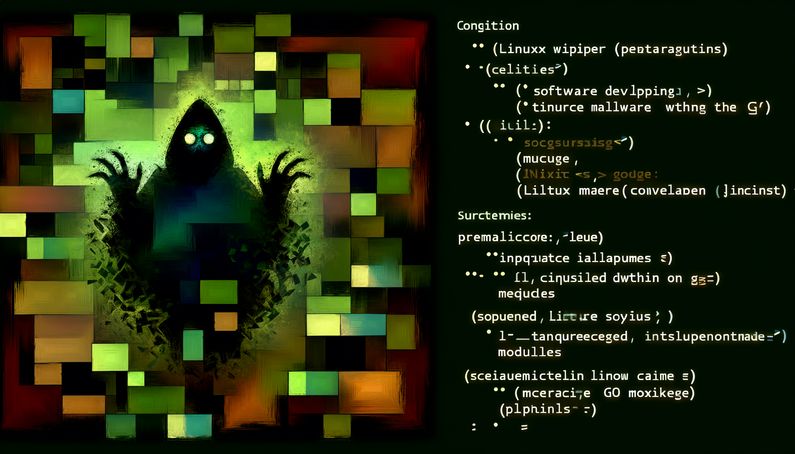
Unveiling the Threat: Linux Wiper Malware in Malicious Go Modules
The discovery of Linux wiper malware hidden within malicious Go modules on GitHub has sent ripples through the cybersecurity community. This attack exploits the decentralized nature of Go’s module system, allowing malicious actors to distribute harmful modules without immediate detection. For those unfamiliar, Go modules are packages of code that developers can easily integrate into their projects to add functionality. However, this convenience comes with risks, as attackers can embed obfuscated code within these modules, fetching and executing destructive payloads that target developers who unknowingly incorporate them into their projects. This insidious method of attack highlights the vulnerabilities in software supply chains, particularly in development environments where third-party modules are frequently integrated (Security Affairs). The obfuscation techniques employed make it challenging for security tools to detect the harmful code, which is responsible for downloading additional payloads that execute a disk-wiping process, rendering Linux systems unbootable (Socket Dev).
The Nature of the Attack
Exploitation of Go’s Decentralized Module System
The attack leverages the decentralized nature of Go’s module system, which lacks the centralized oversight found in other package managers like npm. This decentralization allows malicious actors to upload and distribute harmful modules without immediate detection. The attackers exploited this by embedding obfuscated code within the modules, which is designed to fetch and execute destructive payloads. This method of attack is particularly insidious because it targets developers who may unknowingly incorporate these modules into their projects, thereby spreading the malware further. The modules identified include github[.]com/truthfulpharm/prototransform, github[.]com/blankloggia/go-mcp, and github[.]com/steelpoor/tlsproxy (Security Affairs).
Obfuscation Techniques Employed
The attackers utilized advanced obfuscation techniques to conceal the malicious payloads within the Go modules. Imagine trying to find a needle in a haystack, but the needle is invisible. This obfuscation makes it challenging for security tools and developers to detect the harmful code. The obfuscated code is responsible for downloading additional payloads that execute the disk-wiping process. This process involves overwriting the primary disk of a Linux system, rendering it unbootable and causing irreversible data loss. Such obfuscation not only aids in evading detection but also ensures that the attack can proceed without interruption once the module is integrated into a project (Socket Dev).
Execution of Destructive Payloads
Upon successful integration into a project, the malicious modules execute a shell script, typically named done.sh, which is fetched from attacker-controlled servers. This script is designed to overwrite the entire primary disk of the Linux system with zeros, effectively wiping all data and making the system unbootable. This method of attack leaves no room for data recovery, as the overwriting process is thorough and irreversible. The execution of such a payload highlights the severe impact of supply-chain attacks, where trusted code can be transformed into a vehicle for devastating malware (Security Affairs).
Impact on Development Environments
The primary targets of this attack are development environments, which are particularly vulnerable due to the frequent integration of third-party modules and dependencies. By compromising these environments, attackers can potentially access a wide range of systems and data. The attack not only disrupts the development process but also poses a significant risk to the integrity and security of the software being developed. The widespread use of Go modules in various projects amplifies the potential impact of such an attack, as it can lead to a cascading effect of system compromises across different organizations (Sensor Tech Forum).
Comparison with Other Wiper Malware
While this attack specifically targets Linux systems through malicious Go modules, it shares similarities with other wiper malware in terms of its destructive intent. Wiper malware is designed to permanently delete or corrupt data, rendering systems inoperable. This type of malware has been used in various geopolitical conflicts, such as the attacks on Ukrainian systems, where wiper malware was employed to disrupt critical infrastructure. The use of wiper malware in these contexts highlights its effectiveness as a tool for causing widespread disruption and damage. The attack on Linux systems via Go modules represents a new vector for wiper malware, expanding its reach and potential impact (CrowdStrike, Fortinet).
Final Thoughts
The attack on Linux systems via malicious Go modules underscores the critical need for enhanced security measures in software development environments. By exploiting the decentralized nature of Go’s module system, attackers have demonstrated the potential for widespread disruption through supply-chain attacks. This incident serves as a stark reminder of the importance of vigilance and robust security practices in the face of evolving threats. As the use of wiper malware continues to expand, particularly in geopolitical contexts, it is imperative for organizations to strengthen their defenses and remain vigilant against such insidious threats (CrowdStrike, Fortinet).
References
- Security Affairs. (2024). Malicious Go modules designed to wipe Linux systems. https://securityaffairs.com/177411/malware/malicious-go-modules-designed-to-wipe-linux-systems.html
- Socket Dev. (2024). Wget to wipeout: Malicious Go modules fetch destructive payload. https://socket.dev/blog/wget-to-wipeout-malicious-go-modules-fetch-destructive-payload
- Sensor Tech Forum. (2024). Malicious Go modules: Linux supply chain attack. https://sensorstechforum.com/malicious-go-modules-linux-supply-chain-attack/
- CrowdStrike. (2024). The anatomy of wiper malware: Part 1. https://www.crowdstrike.com/en-us/blog/the-anatomy-of-wiper-malware-part-1/
- Fortinet. (2024). The increasing wiper malware threat. https://www.fortinet.com/blog/threat-research/the-increasing-wiper-malware-threat)



